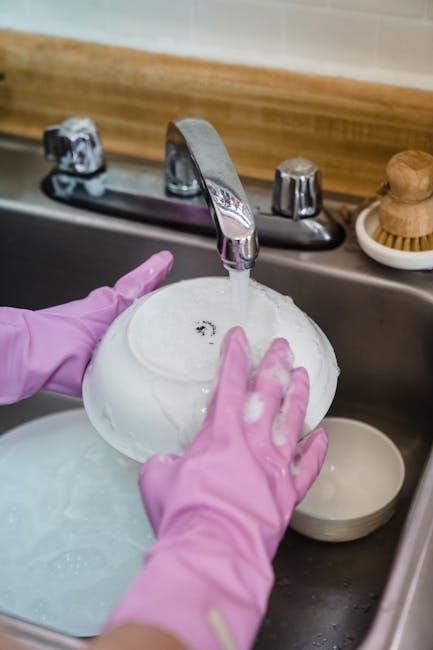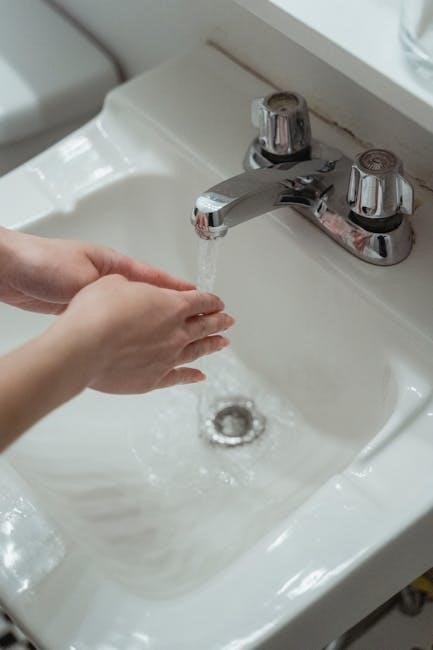A water softener manual is a comprehensive guide providing essential information for installation, maintenance, and troubleshooting. It ensures optimal performance and longevity of your water softening system.
Overview of Water Softener Manuals
A water softener manual is a detailed guide designed to help users understand and operate their system effectively. It typically includes installation steps, maintenance routines, and troubleshooting tips. The manual also provides technical specifications, warranty details, and safety precautions. Whether digital or print, it serves as a resource for optimizing performance and addressing common issues. Diagrams and part lists are often included to aid in repairs and upgrades. By following the manual, users can ensure their water softener functions efficiently, extending its lifespan and maintaining water quality. It’s an essential tool for both new and experienced users.
Importance of Reading Water Softener Manuals
Reading a water softener manual is crucial for proper installation, maintenance, and troubleshooting. It provides detailed instructions tailored to your specific model, ensuring optimal performance and longevity. The manual explains system specifications, safety precautions, and warranty terms, helping you avoid costly mistakes. By understanding the guidelines, you can address common issues promptly, reducing downtime and extending the system’s lifespan. It also offers insights into technical aspects, enabling you to make informed decisions for customization and upgrades. Regularly referring to the manual ensures your water softener operates efficiently, delivering consistent water quality and protecting your home’s plumbing system from damage caused by hard water.

Types of Water Softener Manuals
Water softener manuals come in digital and print formats, offering accessible guides for installation, maintenance, and troubleshooting. Digital manuals are easily searchable, while print versions provide hands-on convenience.
Digital vs. Print Manuals
Digital and print water softener manuals offer distinct advantages. Digital manuals are accessible online, easily searchable, and can be updated regularly. They are ideal for quick reference and troubleshooting. Print manuals provide a tangible guide, perfect for hands-on use during installation or maintenance. Both formats ensure users can access critical information, but digital versions are more environmentally friendly and convenient for remote access. Print manuals remain preferred by those who value physical copies for easy navigation. Choose the format that best suits your needs for optimal convenience and understanding of your water softener system.
Brand-Specific Manuals (e.g., Whirlpool, Fleck, Autotrol)
Brand-specific manuals for water softeners, such as Whirlpool, Fleck, and Autotrol, provide tailored guidance for each system’s unique features and requirements. These manuals ensure compatibility with specific models, offering detailed instructions for installation, maintenance, and troubleshooting. Whirlpool manuals often include user-friendly diagrams, while Fleck manuals emphasize advanced settings and customization. Autotrol manuals focus on smart technologies and regeneration processes. By adhering to brand-specific guidelines, users can maximize their water softener’s performance and extend its lifespan, ensuring optimal water quality and system efficiency tailored to their household needs.

Key Components of a Water Softener Manual
A water softener manual includes installation guides, maintenance schedules, troubleshooting tips, system specifications, and warranty details. These components ensure proper setup, operation, and longevity of the unit.
Installation Instructions
Installation instructions in a water softener manual guide users through the step-by-step process of setting up their system. These instructions typically include selecting a suitable location, connecting pipes, and setting up electrical connections. Detailed diagrams and safety precautions are often provided to ensure a smooth setup. Before starting, users are advised to read the entire manual and gather all necessary tools and parts. Proper installation is crucial for optimal performance and longevity of the water softener. Following the instructions carefully helps avoid common mistakes and ensures the system operates efficiently from the start.
Maintenance and Troubleshooting Guidelines
Maintenance and troubleshooting guidelines in water softener manuals provide users with practical advice for ensuring smooth operation. Regular tasks such as cleaning the resin bed, checking salt levels, and inspecting pipes are often outlined. Troubleshooting sections help diagnose common issues like blockages or timer malfunctions, offering step-by-step solutions. These guidelines empower users to address problems independently, minimizing downtime and extending the system’s lifespan. By following these recommendations, homeowners can maintain optimal water quality and system efficiency, ensuring their water softener performs at its best for years to come.
System Specifications and Technical Details
System specifications and technical details in water softener manuals outline the operational parameters and capabilities of the unit. These include capacity, flow rate, regeneration type, and valve specifications. Understanding these details helps ensure the system meets household needs and operates efficiently. Technical information such as tank size, resin type, and control settings is also provided. These specifications guide users in selecting the right model and configuring it correctly. By referencing these details, homeowners can optimize their water softener’s performance and ensure it effectively addresses water hardness and mineral content. This section is crucial for proper system setup and long-term functionality.
Warranty Information
Warranty information in water softener manuals outlines the coverage and duration of the manufacturer’s guarantee. This section details what parts and labor are covered, as well as the conditions that may void the warranty. Understanding the warranty terms ensures users know their protection and responsibilities. Typically, warranties cover the control valve, resin tank, and brine tank for a specified period. Some manuals also provide instructions on how to file a warranty claim and the required documentation. This information is crucial for maintaining coverage and ensuring the system remains under protection for its intended lifespan.

Understanding Your Water Softener Manual
Understanding your water softener manual is key to optimizing performance and troubleshooting issues. It provides clear guidance on technical terms, system operation, and effective usage for better results;

How to Use the Manual Effectively
To use your water softener manual effectively, start by skimming the index to locate key sections quickly. Always follow the installation steps in order to avoid setup errors. Pay attention to highlighted sections, such as maintenance schedules and troubleshooting guides, as these are crucial for long-term performance. Use online resources or brand-specific guides for additional clarity. Regularly test your water hardness and refer to the manual for ideal settings. Familiarize yourself with error codes and their solutions to address issues promptly. By following these steps, you can maximize your water softener’s efficiency and extend its lifespan.
Common Technical Terms Explained
Understanding technical terms in your water softener manual is crucial for effective use. Hard water refers to water with high calcium and magnesium levels, while soft water has these minerals removed. Regeneration is the process where the system cleans itself by flushing out accumulated minerals. Grains per gallon (gpg) measures water hardness. Resin beads are the medium that removes minerals, and the brine tank holds the salt solution used in regeneration. Familiarizing yourself with these terms ensures proper system operation and maintenance, helping you troubleshoot issues and optimize performance effectively.

Advanced Features of Water Softeners
Modern water softeners include smart features like water usage monitoring and real-time alerts, enhancing efficiency and user experience. These advanced systems optimize performance and reduce maintenance needs effectively.
Smart Features in Modern Water Softeners
Modern water softeners now include innovative smart features designed to enhance efficiency and user convenience. These systems often come with water usage monitoring, allowing homeowners to track their consumption patterns. Real-time alerts notify users of issues like low salt levels or system malfunctions, ensuring prompt maintenance. Some models offer app connectivity, enabling remote monitoring and adjustments. Additionally, smart regeneration features optimize water and salt usage by only regenerating when necessary. These advanced technologies not only improve performance but also reduce energy and resource waste, making them a valuable upgrade for households seeking convenience and sustainability.
Regeneration Types (Time-Initiated vs. Demand-Initiated)
Water softeners operate using two primary regeneration types: time-initiated and demand-initiated. Time-initiated regeneration occurs on a fixed schedule, regardless of actual water usage, ensuring consistent system maintenance. This method is simple but may not always align with household needs, potentially wasting resources. Demand-initiated regeneration, on the other hand, adjusts based on actual water usage, activating only when necessary. This smart approach optimizes water and salt consumption, making it more efficient for homes with varying water demands. Understanding these types helps users choose a system that best fits their lifestyle and consumption patterns.

Troubleshooting Common Issues
Common issues include blockages, timer malfunctions, and error codes. Check for obstructions in valves and hoses. Reset timers or consult error code guides for solutions.
Identifying and Solving Blockages
Blockages in water softeners often occur in valves, hoses, or resin tanks. Symptoms include reduced water flow or pressure. To identify blockages, inspect connections for debris or mineral buildup. Use a soft brush or vinegar solution to clean affected areas. Replace any damaged parts to restore proper function. Regular maintenance, such as cleaning and checking for sediment, can prevent blockages. Refer to your manual for specific instructions tailored to your system. Addressing blockages promptly ensures efficient operation and extends the lifespan of your water softener;
Timer and Regeneration Problems
Timer and regeneration issues are common in water softeners, often caused by power outages, incorrect settings, or faulty valves. Symptoms include inconsistent regeneration cycles or failure to regenerate. To resolve, check the timer settings, ensure proper power supply, and clean or replace faulty components. Refer to your manual for troubleshooting guides specific to your model. Regularly checking and adjusting the timer and regeneration settings can prevent these issues and ensure optimal system performance. Always consult the manual for detailed instructions tailored to your water softener brand and model.
Understanding Error Codes
Water softener error codes are designed to help users quickly identify and address system issues. These codes, specific to each brand and model, provide clear indicators of problems such as sensor malfunctions, flow restrictions, or software glitches. By referencing your manual, you can decode these errors and take corrective action. For example, some codes may signal low salt levels, while others indicate valve or timer issues. Regularly reviewing error codes ensures timely resolutions, preventing prolonged system downtime. Always consult your manual for a detailed list of codes and their meanings specific to your water softener model.

Selecting the Right Water Softener
Choosing the right water softener involves considering household size, water usage, and hardness levels. Select models with features like smart technology for optimal performance and efficiency.
Choosing the Correct Size for Your Household
Selecting the right-sized water softener is crucial for efficient operation. A unit that’s too small may not soften water adequately, while an oversized one wastes resources. Measure your household’s water usage and hardness levels to determine the ideal capacity. Consider the number of people and appliances to ensure the softener meets demand without excess. Proper sizing ensures optimal performance, reduces maintenance, and extends the system’s lifespan. Refer to your manual for guidance on calculating the correct size based on your specific needs and water conditions.
Factors to Consider (Usage, Hardness Levels)
When selecting a water softener, consider your household’s water usage and hardness levels. Usage is determined by the number of people and appliances, while hardness levels are measured in grains per gallon (gpg). Higher hardness requires a more robust system. Assessing these factors ensures the softener effectively removes minerals like calcium and magnesium. Refer to your manual for guidance on testing and setting ideal levels. Proper configuration based on these factors optimizes performance, reduces maintenance, and extends the system’s lifespan, ensuring softened water meets your household’s needs efficiently.

Water Testing and Hardness Setting
Water testing determines total hardness (gpg) and dissolved iron (ppm) to set ideal levels. Use strips or digital testers for accurate measurements, ensuring optimal softener performance.
How to Test Water Hardness
Testing water hardness is crucial for setting your softener correctly. Use test strips or a digital hardness tester for accurate results. Dip the strip in water, compare the color to the chart, and determine hardness levels. For digital testers, submerge the probe and read the ppm or gpg value. Regular testing ensures optimal softener performance and adjusts settings as needed. Always test after installation or noticeable water quality changes. Accurate measurements prevent over- or under-softening, ensuring efficient operation and extending system lifespan.
Setting the Ideal Hardness Levels
Setting the ideal hardness levels ensures your water softener operates efficiently. Refer to your manual for specific instructions on adjusting settings. Typically, enter the hardness value measured during testing into the control panel. For most households, a target range of 1-3 grains per gallon (gpg) is recommended. Adjust settings based on usage and preferences. Higher levels may leave residue, while lower levels can waste salt. Regular monitoring and adjustments maintain water quality and system efficiency, ensuring soft water without over-softening. Proper settings also help extend the lifespan of your water softener.

Maintenance and Upkeep
Regular maintenance ensures your water softener performs optimally. Clean the brine tank, check salt levels, and inspect resin beds to prevent blockages and extend system lifespan.
Routine Maintenance Tasks
Regular maintenance is crucial for optimal water softener performance. Clean the brine tank every 1-2 months to prevent salt bridges and ensure proper regeneration. Check salt levels monthly, refilling as needed to maintain efficiency. Inspect resin beds annually for wear or blockages, and replace them if necessary. Monitor water hardness levels to adjust settings accurately. Ensure the system’s drain is clear to prevent backups. Replace filters every 6-12 months to maintain water quality. Refer to your manual for specific instructions tailored to your model. Consistent upkeep extends the lifespan and effectiveness of your water softener.
How to Extend the Lifespan of Your Water Softener
To maximize the lifespan of your water softener, adhere to routine maintenance schedules outlined in the manual. Regularly clean the brine tank and resin bed to prevent mineral buildup. Ensure proper salt levels and use high-quality salt to avoid contamination. Replace worn-out parts promptly, such as valves and seals, to prevent leaks and inefficiency. Monitor water hardness settings to avoid over-regeneration. Perform annual system checks and professional servicing if recommended. Proper care and adherence to manual guidelines can extend the system’s longevity and maintain its efficiency over time.
A water softener manual is your key to optimal performance and extended system life. Follow its guidelines to ensure efficiency, reduce maintenance, and enjoy better water quality.
Final Tips for Optimal Water Softener Performance
Regularly maintaining your water softener ensures longevity and efficiency. Schedule annual professional inspections and keep the brine tank filled. Monitor salt levels and adjust settings based on water hardness tests. Replace the resin bed when necessary to maintain performance. Always follow the manual’s installation and maintenance guidelines to avoid system damage. Stay informed about new features and upgrades to enhance functionality. Proper care and adherence to the manual’s instructions will ensure your water softener delivers soft, clean water consistently, benefiting your entire household.
